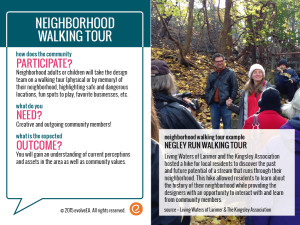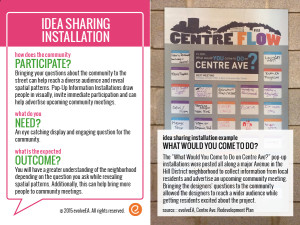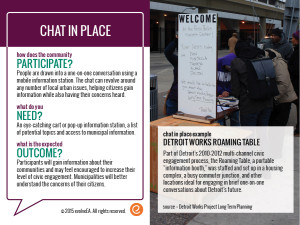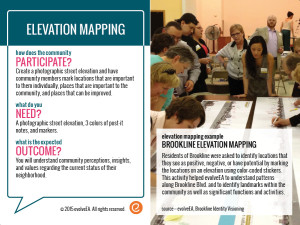Creating Resiliency Through Community Engagement
Just and resilient cities rely on empowered communities—we believe that design is key to that process. Our work as designers can help a community establish relationships, gain knowledge, and be better prepared to face dynamic challenges. Successful projects depend on community partners who provide knowledge and motivation and build a tribe of people who carry forth the efforts long after the design team is gone.
We believe that engaging communities in design thinking is an important way to create a successful project from planning and design through implementation. To help make this happen, we’ve been collecting and sharing strategies that are rooted in activated community design principles. The strategies allow communities to define their issues as well as the ways of resolving them—problem seeking as well as problem solving. While some strategies might seem to be for fun, each activity is rooted in an exchange—an exchange of knowledge, effort, or ideas—and helps to build community capacity for the next big challenge. We have collected these strategies in a deck of cards that helps us plan our community engagement agenda for each design project.
During our process for Pittsburgh Hill District’s Centre Avenue Corridor Redevelopment and Design Plan, for example, we worked with the Hill Community Development Corporation on a campaign over several months to engage the community at open meetings, where they shop, and online. The community’s input shaped a neighborhood identity that they could proudly integrate into development projects with greater autonomy and cohesion.
More About the Importance of Community Capacity
To understand community resiliency, we need to understand what the capacity of the community is to respond or to proactively address their own issues. We define Community Capacity in four ways:
- Does the community have strong Decision-making mechanisms in place?
- Are they able to share knowledge and have strong Organizational Learning methods?
- Do they have Legal Structure, that they would need to act in their domain?
- Do they have the Financial Resources that are required in order to take action?
Designing our communities is both design of place as well as design of processes that enliven those places. This means communities need to think spatially and think of the things that are visible or experiential in their community. It also means that they need to think about the flow of resources (people, money, food, energy, water, etc.) through their community over time. Community engagement needs to give people the tools to shape both the visible and the invisible.
High capacity communities have the tools to “get to scale,” which is essential to community self-determination, especially in strong market situations. Developers can make decisions and implement large projects because they have decision making capacity, are able to retain and share knowledge, they have legal structure and financial resources. They have those same elements that we define as community capacity. While a community group may play a fundamentally different role than a developer, a community that lack these resources can find themselves in an asymmetrical or oppositional relationship.

How can we help a community raise their capacity so they can get to this larger scale and deploy what is often a more effective strategy for community development?
More About the Community Engagement Strategy Deck
In addition to documenting our own strategies, we follow the methods that others have deployed in their work at a variety of scales all over the world. We have collected over 30 of our favorite strategies for the Community Engagement Strategy Deck, which design teams and communities can use to plan outreach and activation for various types of projects.
The deck has been tested in the field, and through workshops at international conferences where design professionals have studied the strategies to consider where and when certain methods should be deployed. By changing the paradigm of community participation to community activation, these strategies help raise organizational and community capacity so that grassroots initiatives can ultimately yield successful and resilient neighborhoods.





